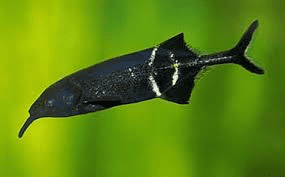
Common name: Elephant Nose Fish, Peter’s Elephantnose
Scientific name: Gnathonemus Petersii
Average Adult Fish Size: 8 inches / 20 cm
Place of Origin: It has a vast distribution and has been recorded in Mali, Benin, Niger, Nigeria, Chad, Central African Republic, Cameroon, Republic of Congo, Democratic Republic of Congo and Zambia.
Typical Tank setup: This is a nocturnal fish, so dim lighting is required to make it feel secure. Plenty of cover should also be provided, particularly if you’re keeping a few together. Smooth rocks, driftwood and plants that can survive under low lighting, such as Anubias sp., java fern and Vallisneria can all be used. A sand substrate is absolutely critical to the well-being of this species, as it burrows into it with it’s proboscis-like lower lip. Sharp-edged or coarse substrates can damage the mouthparts of the fish and prevent it from feeding naturally.
Recommended Minimum Aquarium Capacity: 60 gallon / 240 litre
Compatibility: A quiet but territorial species. It is peaceful towards heterospecifics, although it should not be kept with very active or aggressive species, as it will be out-competed at feeding time. It also does not mix well with other mormyrids. Suggested tankmates include other African species such as Butterfly fish, smaller bichirs, Congo tetras, Synodontis catfish and Ctenopoma species. G. petersii can also be kept successfully with peaceful cichlids such as Satanoperca, some Geophagus and Angelfish.
It’s less easily kept with conspecifics. Buying only 2 is not recommended, as the stronger will often bully the weaker to death. If you wish to keep more than one of these you’ll need a suitably large tank with lots of hiding places. Buy at least 5 fish in order to disperse aggression within the group.
Temperature: / 73 – 82 Deg F / 23 – 28 Deg C
Water chemistry: pH 6.0 – 7.5
Feeding: Most specimens are quite unfussy and will accept a range of dried, frozen and live foods. Worms of any kind are a particular favourite of G. petersii.
Sexing: It cannot be sexed by external means (some sources suggest the shape of the anal fin may be significant), although the sexes can be distinguished by examining the electric fields produced by the fish. Obviously this approach is not an option for the general aquarist.
Breeding: Not thought to have been achieved in captivity. One scientific study suggests that being kept in the confines of an aquarium causes the sexually-defining patterns of electric impulses to become less clearly defined or even reversed. This means the fish cannot recognise members of the opposite sex, and inhibits spawning.
Additional Information: Also known as Peter’s elephantnose, this fascinating species is currently the most common Mormyrid in the hobby. Sadly, its popularity means it is often kept in unsuitable conditions. To deny the fish a soft substrate really is cruel, as it uses its “trunk” to locate food hidden in the substrate. It also needs dim lighting, and will commonly become withdrawn and pine away if kept under bright lights. If you cannot provide suitable lighting, add food to the tank at lights out to allow the fish to feed, along with plenty of cover for them to hide in during tanklight hours.
Like other scaleless fish, it is sensitive to many aquarium medications, including salt. It is also very sensitive to deteriorating water conditions and is actually used as an indicator of water quality in municipal supplies in parts of Germany and the US. The frequency of its electrical discharges increases as the water becomes more polluted. When maintained correctly, however, it makes a superb addition to the African biotope aquarium, or a community of compatible species.
Like other Mormyrids, it produces a weak electric field using specially-adapted muscle tissue located towards the tail. It also possesses electroreceptors which allow the fish to receive electrical signals. With these, the fish can sense the tiniest of movements as the field around it is disturbed, and navigate in total darkness, useful skills for a poorly-sighted fish when hunting prey or avoiding predators in the gloom. What is most fascinating about this adaptation is that the fish also use it to communicate with each other and find partners.
Mormyrids also have relatively large brains, possessing the equivalent of a human brain in terms of its size. There are 3 different types of electroreceptors that carry information to different parts of this, amazingly allowing G. petersii to distinguish between different species of fish and ascertain the sex of conspecifics in total darkness!


Related Posts
Croaking Gourami – Trichopsis vittatus
Benthochromis Tricoti
Large-eyed Mouthbrooder – Callochromis Macrops